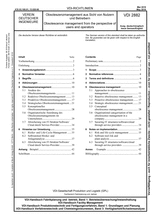
Technical rule [CURRENT]
VDI 2882:2018-05
Obsolescence management from the perspective of users and operators
- German title
- Obsoleszenzmanagement aus Sicht von Nutzern und Betreibern
- Publication date
- 2018-05
- Original language
- German, English
- Pages
- 44
- Publication date
- 2018-05
- Original language
- German, English
- Pages
- 44
Product information on this site:
Quick delivery via download or delivery service
Buy securely with a credit card or pay upon receipt of invoice
All transactions are encrypted
Short description
Obsolescence means that a component or - as a consequence of it- a complete assembly (processes, materials, software, production equipment, system) is no longer available during its service life. Operators and suppliers must together give thought as early as at the time of procurement on how to ensure a product is operable and has access to a supply of replacement components over the entire duration of its service life. The component availability over the full life span of the system is to be included as a core issue in all considerations. Obsolescence cases occur due to the rapidly rising number of innovations as well as the "electronification" in all sectors of the capital goods industry (assets, capital goods, infrastructure, durable consumer goods, consumables and software products). The standard describes concepts to ensure the usage (e.g. through availability of spare parts) of systems and components that are (or will become) older than 10, 20, or 30 years. The obsolescence management can be considered as part of risk management. Properly carried out, it aims at preventing or reducing production or service failures due to outdated or no longer available processes, materials, software, production facilities, etc., or lost know-how.
Content
ICS
03.100.01,
13.020.60
Also available in
Loading recommended items...
Loading recommended items...
Loading recommended items...
Loading recommended items...

